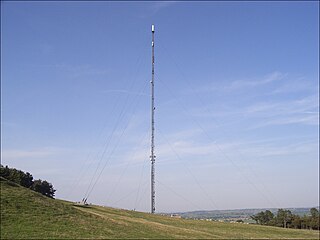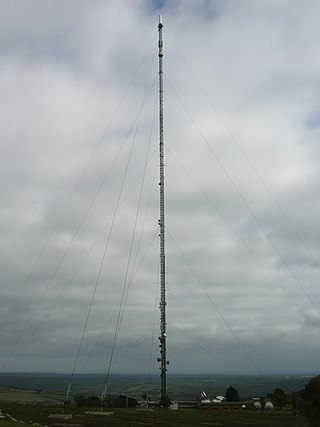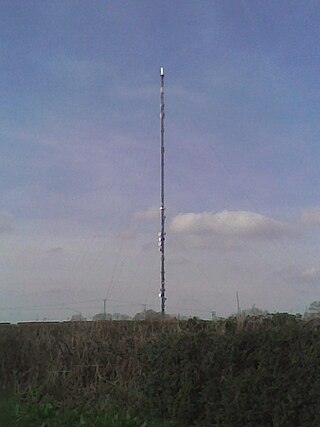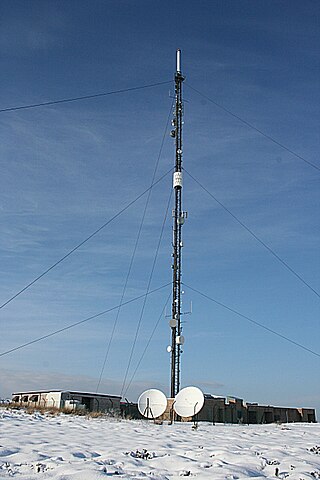The Sutton Coldfield transmitting station is a broadcasting and telecommunications facility located in Sutton Coldfield, Birmingham, England. In terms of population covered, it is the third most important transmitter in the UK, after Crystal Palace in London and Winter Hill near Bolton.

The Belmont transmitting station is a broadcasting and telecommunications facility next to the B1225, 1 mile (1.6 km) west of the village of Donington on Bain in the civil parish of South Willingham, near Market Rasen and Louth in Lincolnshire, England. It is owned and operated by Arqiva.

The Mendip transmitting station is a broadcasting and telecommunications facility on the summit of Pen Hill, part of the Mendip Hills range in Somerset, England, at 305 metres (1,001 ft) above sea level. The station is in St Cuthbert Out civil parish, approximately 2 miles (3.2 km) north-east of Wells. Its mast, 293 m (961 ft) high, was built in 1967 and is the tallest structure in South West England. The mast broadcasts digital television, FM analogue radio and DAB digital radio, and had broadcast analogue colour television from 1967 until 2010.

The Winter Hill transmitting station is a broadcasting and telecommunications site on Winter Hill, at the south eastern boundary of the Borough of Chorley, Lancashire, England, and above Bolton. It is owned and operated by Arqiva.

The Waltham transmitting station is a broadcasting and telecommunications facility at Waltham-on-the-Wolds, 5 miles (8 km) north-east of Melton Mowbray. It sits inside the Waltham civil parish near Stonesby, in the district of Melton, Leicestershire, UK. It has a 315 metres (1,033 ft) guyed steel tubular mast. The main structure height to the top of the steelwork is 290.8 metres (954 ft), with the UHF television antennas contained within a GRP shroud mounted on top.

The Croydon transmitting station is a broadcasting and telecommunications facility on Beaulieu Heights in Upper Norwood, London, England, in the London Borough of Croydon, owned by Arqiva. It was established in 1955 and initially used a small lattice tower. The present tower is 152 metres (499 ft) high and was built in 1962.

The Alexandra Palace television station in North London is the oldest television transmission site in the world. What was at the time called "high definition", (405-line) the world's first TV broadcasts on VHF were beamed from this mast from 1936 until the outbreak of World War II. It then lay dormant until it was used very successfully to foil the German Y-Gerät radio navigation system during the last stages of the Battle of Britain. After the war, it was reused for television until 1956, when it was superseded by the opening of the BBC's new main transmitting station for the London area at Crystal Palace. In 1982 Alexandra Palace became an active transmitting station again, with the opening of a relay transmitter to provide UHF television service to parts of North London poorly covered from Crystal Palace.

The Moel-y-Parc transmitting station is situated on Moel y Parc, a hill in north-east Wales at the northern end of the Clwydian range, close to the town of Caerwys and several miles (kilometres) north-east of Denbigh. It was built in 1962/1963 by the IBA to bring 405-line VHF ITV television to North Wales and it has been on the air since 1963. Its original height of 229 metres (751 ft) made it the tallest structure in North Wales and it stands on land that is itself about 335 metres (1,099 ft) above sea level. In 1965, VHF television transmissions from the BBC commenced from the site.

The Rowridge transmitting station is a facility for FM radio and television transmission at Rowridge on the Isle of Wight in southern England.
The Llanddona transmitting station is a broadcasting and telecommunications facility, situated at Llanddona, near Beaumaris, on the isle of Anglesey, Wales. It comprises a 106.7 metres (350 ft) guyed mast with antennas attached at various heights. It is owned and operated by Arqiva.

The Wenvoe transmitting station, officially known as Arqiva Wenvoe, is the main facility for broadcasting and telecommunications for South Wales and the West Country. It is situated close to the village of Wenvoe in the Vale of Glamorgan, Wales, in the UK.
The Ridge Hill transmitting station is a broadcasting and telecommunications facility located 8.5 miles SE of Hereford in Herefordshire, and close to the border of Gloucestershire. The station transmits the full complement of digital terrestrial multiplexes and an additional ITV West Multiplex. It includes a cable stayed steel lattice mast which has a height of 164.6 metres (540 ft), which in addition to the altitude of the site gives an aerial height of 363 metres (1,191 ft) above mean sea level.

The Preseli transmitting station is a broadcasting and telecommunications facility on the eastern end of the Preseli Mountains, close to the villages of Crymych and Pentre Galar in Pembrokeshire, Wales. It is owned and operated by Arqiva.
The Oxford transmitting station is a broadcasting and telecommunications facility, situated on land 129.5 metres (425 ft) above Ordnance Datum to the north east of the city of Oxford, in Oxfordshire, England. It has a guyed steel lattice mast which is 154.4 metres (507 ft) in height to the top of the main steel structure. The UHF television antenna, which consist of a vertical array of transmitting panels, is mounted above the steel structure. The total height of the mast to the top of this UHF antenna is 165.7 metres (544 ft). It is owned and operated by Arqiva.

The Haverfordwest transmitting station is a broadcasting and telecommunications facility located at Woodstock about 13 km (8 mi) to the north east of the town of Haverfordwest, in Pembrokeshire, Wales. It was originally built by the BBC, entering service in early 1964 acting as a main transmitter for the 405-line VHF television system, and as a repeater for Band 2 VHF FM radio received off-air from Blaenplwyf transmitting station. It is now owned and operated by Arqiva.

The Stockland Hill transmitting station is a transmitting facility of FM Radio and UHF television located near Honiton, Devon, England.

Huntshaw Cross transmitting station is a telecommunications facility serving North Devon including the towns of Barnstaple and South Molton. It broadcasts television, radio and mobile telephone services and is currently owned by Arqiva. It is located on the B3232 road at Huntshaw, Great Torrington. Grid reference SS527220. The mast is 164 metres (538 ft) high.

Storeton transmitting station is a television transmitter being a member of both the Winter Hill group of transmitters and of the Moel-y-Parc group of transmitter, and an FM radio transmitter, with transmitting antennas affixed to a mast located on Storeton Ridge, Higher Bebington, Wirral, UK. The site is owned and operated by Arqiva. It was originally solely an analogue TV relay of the Winter Hill transmitter. The 45 metre-high (150 ft-high) mast is situated at an elevation of 65.5 metres (215 ft). Thus, the top of the mast has an overall height of 110.5 metres (363 ft) above sea level. Construction of the mast was completed in 1980. As of 2009, the TV transmitter serves approximately 45,000 homes.
The Mynydd Emroch television relay station is sited on the eponymous hill to the east of Port Talbot. It was originally built in the 1970s as a fill-in relay for UHF analogue television. It consists of a 25 metres (82 ft) self-supporting lattice tower standing on a hillside which is itself 600 ft above sea level. The transmitters are beamed southwards to cater for those digital terrestrial TV subscribers in Port Talbot and Margam which for reasons of geography can't get a signal from the Kilvey Hill transmitter across the bay at Swansea. The Mynydd Emroch transmission station is owned and operated by Arqiva.

The Knock More transmitting station is a broadcasting facility, located at Knock More, to east of the parish of Boharm, Scotland, in Moray. It is a guyed steel lattice mast which stands 113 metres (371 ft) high. The mast is located on elevated ground which is about 355 m above sea level, and is between Elgin and Keith. It was built by the Independent Broadcasting Authority (IBA) to improve and extend UHF television coverage in north east Scotland, and is now owned and operated by Arqiva.

















